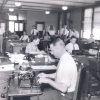calsfoundation@cals.org
Alfred Edgar Smith (1903–1986)
Alfred Edgar Smith was active in the battle for equal rights for African Americans as an author, government worker, educator, journalist, and club leader.
Alfred Smith was born in Hot Springs (Garland County) on December 2, 1903. His parents were Jesse Rufus Smith, born in slavery in Roanoke, Virginia, and Mamie Johnson Smith. Both worked at the Arlington Hotel in Hot Springs. Later, the couple began to work at the Crystal Bathhouse, a spa for African Americans. Jesse became manager and Mamie the bookkeeper.
Smith worked his way through Langston High School as a night bellhop for the Eastman and Arlington Hotels and as an exercise boy at Oaklawn Park Racetrack (now Oaklawn Racing Casino Resort). He was a member of a Langston High School choir that sang spirituals for famous visitors to Hot Springs.
When he had saved enough money to pay the fees, Smith entered Howard University in Washington DC in 1920. He was adept at English and social studies. He had problems in trigonometry, algebra, calculus, and astronomy and hired a West Indian student to tutor him in mathematics.
He became aware that West Indians were discriminated against on the campus at Howard. W. E. B. Du Bois, editor of the Crisis Magazine, encouraged him to write an essay about the treatment of West Indians on the campus. The article was published in the Urban League magazine Opportunity in 1933.
Smith received a BA degree in social science in 1928 and an MA degree in history in 1932 from Howard University. He worked at the U.S. post office in Washington DC from 1929 to 1931 and as a substitute teacher during 1931 and 1932. He served as a research assistant to several Howard University professors and to race relations officers in Washington. He worked for federal officials from both the Federal Emergency Relief Administration (FERA) and the Works Progress Administration (WPA) from 1934 to 1943 and became a member of President Franklin D. Roosevelt’s Federal Council on African American Affairs. During his service as a research assistant for FERA, he served with Forrester Washington. FERA was used by government agencies dealing with the effects of the Great Depression. In less than a year, Smith replaced Washington as Director of Colored Work in FERA. These top government advisors, Roscoe C. Brown, Robert C. Weaver, and Mary McCleod Bethune, to name three of the twenty-one members, called themselves the Federal Council on Negro Affairs, known as the Black Cabinet.
In 1942, Smith married Lula Jackson, of Savannah, Georgia. During that same year, in reaction to the National Press Club’s policy of excluding African Americans, he founded the Capital Press Club as a professional organization for black journalists in Washington DC. Smith served as the organization’s first president, and in 1948, he received the club’s “Newsman of the Year” award.
From 1940 to 1943, Smith was a columnist for the Chicago Defender. His pen name was “Charlie Cherokee.” He wrote articles about the feuds at Howard University and editorial comments about World War II, democracy, and race. The columns became a favorite of the black GI, especially those overseas that regarded the column as their champion against discrimination.
He was bureau chief and columnist for the Chicago Defender, also serving as confidential advisor or agent for the Department of Defense. He was a columnist, stringer, and freelance writer for Ebony and the Negro Digest. In 1949, Smith wrote for the Chicago Globe as a freelance writer and publisher.
From 1949 to 1954, Smith was the information officer for the Civil Defense Administration. From 1954 to 1961, he was the race relations officer for the Public Housing Administration of the Northeastern Region (which included New England, New York, New Jersey, and Pennsylvania).
In 1961, Smith became the information officer for the U.S. Department of Labor, serving under Secretary of Labor Arthur Goldberg and later for Willard Wirtz under President John F. Kennedy. He retired from government service in 1974. Upon retirement, Wirtz congratulated him for having played a vital part in one of the most significant chapters in U.S. history—the battle to win equal opportunity and results for African Americans. While in Washington DC, he returned occasionally to Arkansas, especially to see his sister and her family.
Smith died of renal failure at George Washington University Hospital on May 26, 1986, and was buried the next day in Rock Creek Cemetery in Washington DC. When talking about his successes, Smith said, “I am an Ozark hillbilly…if slightly off color, lean and mean and tough as a ten penny nail.”
For additional information:
Alred Edgar Smith Papers. Special Collections. University of Arkansas Libraries, Fayetteville, Arkansas.
Bunche, Ralph J. The Political Status of the Negro in the Age of FDR. Chicago: University of Chicago Press, 1973.
Hodges, Norman. Black History. New York: Simon and Schuster Press, 1971.
Hughes, Langston, Milton Meltzer, and C. Eric Lincoln. A Pictorial History of Black Americans. New York: Crown Publishers, Inc., 1973.
McLane, Bobby Jones. “A Slightly Off-Color Hillbilly.” The Record 25 (1984): 21–30.
Izola Preston
Fayetteville, Arkansas
Gordon D. Morgan
University of Arkansas, Fayetteville
This entry, originally published in Arkansas Biography: A Collection of Notable Lives, appears in the CALS Encyclopedia of Arkansas in an altered form. Arkansas Biography is available from the University of Arkansas Press.
 Civil Rights and Social Change
Civil Rights and Social Change Mass Media
Mass Media World War II through the Faubus Era, 1941 through 1967
World War II through the Faubus Era, 1941 through 1967




Comments
No comments on this entry yet.